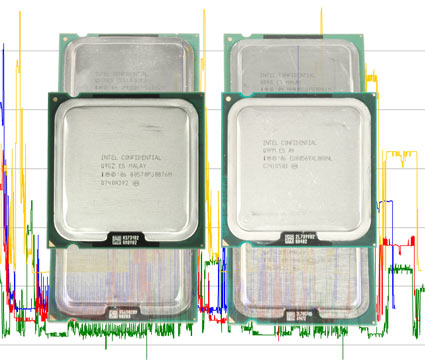Overclocking Intel's Wolfdale E8000
The Tale Of Wolfdale: Power Requirements And Overclocking Analyzed

Only a few days ago we looked at the performance of Intel's new Core 2 dual core processors, the Core 2 Duo E8000 series, aka Wolfdale. While a 45 nm quad core Extreme edition processor (Yorkfield) has been available since early winter, the dual-core processors for the mainstream had not been released until recently. As the first Wolfdale review made clear, the new dual core processors provide a nice performance boost when compared to the 65 nm Core 2 Duo E6000 generation. This time we want to look at the overclocking potential and the power requirements of the new Wolfdale-based 45 nm Core 2 E8000 processors, as the enthusiast crowd has very high expectations since 65 nm Core 2 Duo Conroe already is an amazing overclocker Compare Prices on Core 2 Duo Processors.
Core 2 processors have served the overclocking community well since their debut. Unlike AMD, which must produce its 90 nm processors closer to their technical and thermal limits to stay competitive, Intel plays on its manufacturing prowess, which is at least 12 months ahead of that of AMD. The Santa Clara-based firm outputs most of its mainstream processors with a 65 nm process (internally called P1264) and has been producing 45 nm processors based on P1266 since the third quarter of last year. AMD continues to rely on the mature 90 nm process and is still optimizing its own 65 nm process as well as the Phenom design, which has been behind schedule.
If you look at the maximum clock speed AMD has been offering in its dual-core portfolio, which is 3.2 GHz in case of the Athlon 64 X2 6400+, and compare it to the clock speeds users reach by overclocking them (that would be only 100 - 200 MHz more), there is not much of a margin left. However, Intel Core 2 processors' in retail channels offer clock speeds up to 3.0 GHz, and many of these devices can easily be overclocked to more than 4 GHz. Even if you decided to opt for a low-cost Pentium Dual Core E2100 model (with a 1.6 GHz to 2.0 GHz default clock speed), you'd still be able to overclock the processor to at least 2.8 GHz. During the tests, the device even remained stable at 3.2 GHz, which equals a clock speed increase of over 50%. This certainly does not mean, of course, that AMD's processors, especially its lower-end mainstream 65 nm devices, are not geared for good overclocking results, either. However, AMD's overclocking margins haven't been as large compared to what Intel's modern processors offer.
We have published a number of articles on either the Core 2 topic or topics related to overclocking systems based on Core 2:
- Cheap Thrills: Core 2 Duo E6400 Overclocked to 3.33 GHz
- Overclocking: Dual Core vs. Quad Core
- Extreme FSB: Taking the E6750 Beyond 4 GHz
- Extreme FSB2: The Quad Core Advantage?
- 500 MHz FSB: Core 2 Duo Overtakes Core 2 Extreme
- $89 Pentium Dual Core Runs 3.2 GHz
- Overclocking Guide, Part 1: Risks, Choice and Benefits
This article contains lots of basics on overclockings, components that can be overclocked and how to get started.
- Overclocking Guide, Part 2: Suggested Components and Settings
- Overclocking Guide, Part 3: How to Gain 81% for $27
- Intel Skulltrail, Part 2: Overclocking & Power
Intel's new dual-socket eight core Skulltrail platform can be overclocked to over 4 GHz.
This is an interesting article on overclocking very high-end devices using somewhat extreme cooling techniques.
Stay On the Cutting Edge: Get the Tom's Hardware Newsletter
Get Tom's Hardware's best news and in-depth reviews, straight to your inbox.
Knowing that the 65 nm Core 2 Duo Conroe overclocks well at up to 4 GHz, and considering that Intel has released the new 45 nm E8000 processors at a maximum clock speed that is only slightly above the maximum speed of the E6000 series (3.16 GHz vs. 3.0 GHz), people are eager to see where the new core can take the power-efficient Core 2 architecture. We also wanted to know what the potential power savings are for the new generation. To look into this, we did not only measure the minimum and maximum power requirements of the test systems, but we tracked the system's power consumption over the duration of a certain workload using SYSmark 2007. These tests resemble what we did when we compared the power efficiency of current and older AMD and Intel processors:
Current page: The Tale Of Wolfdale: Power Requirements And Overclocking Analyzed
Next Page System Checkup-
LLJones What? Seriously? No one was reading Tom's back at this time or what?Reply
Good article as I am revamping and older system and want to know how the Wolfdale OC'd. Thanx for the info.